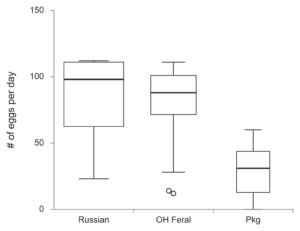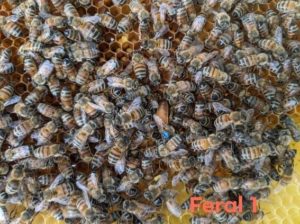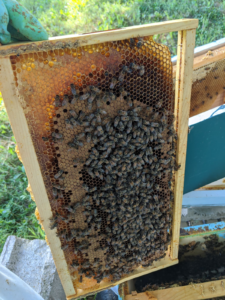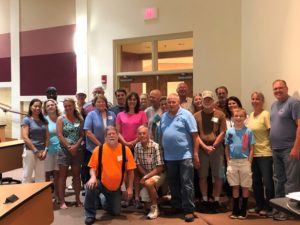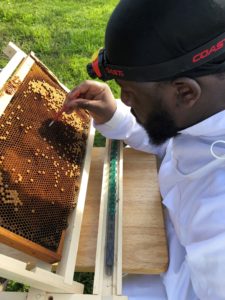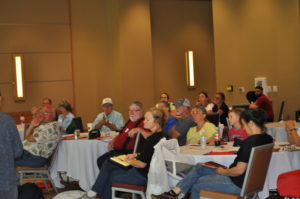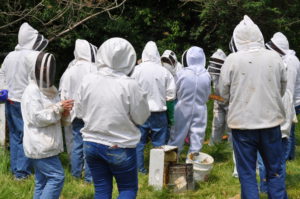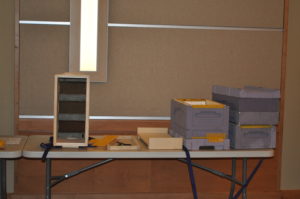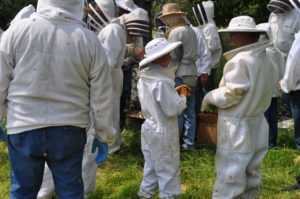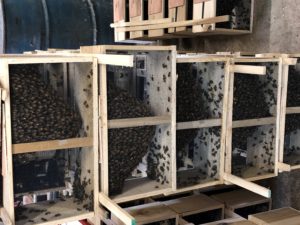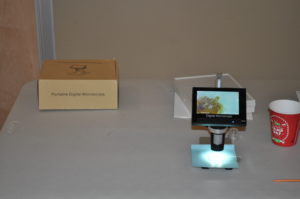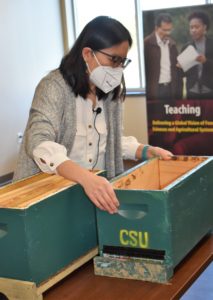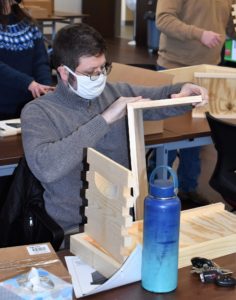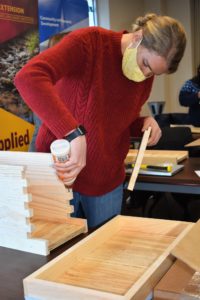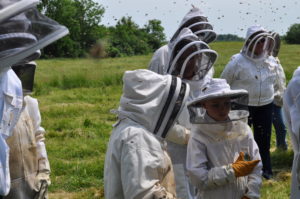Final report for ONC19-062
Project Information
Honeybees are the most important managed pollinators contributing $15 billion to the US economy. However, managed bee colonies are in a 60% annual decline in Ohio. The ectoparasitic mite Varroa destructor is the most severe factor for the disease and weakness of the colonies since 1987. Promoting mite resistant bees is one of the most effective ways to mitigate bee decline. We have a collection of bee stocks from feral colonies that are mite resistant. However, the limit factor for local honeybee resources is fewer queens and nuclei available to fulfill the demand of beekeepers in the region.
Working with experienced queen producers in 2019-2022, we aim to improve the queen quality of honeybee stocks by using the queen cells. We have tested the quality and colony demographics of 48-hr queen cells from either commercial package bees (n=6), feral stocks (n=6), or Russian bees (n=7). We had difficulties using the commercial package bees to produce queen cells in 2020 probably due to the biology of these bees. In 2021, we adjusted our methods to use both queen cells and adult queens for both commercial package bees and feral stocks.
We held two workshops in 2019 for Southern and Western Ohio beekeepers. Both workshops integrated lectures and field demonstrations on queen quality, queen cells, and discussions on how to do queen rearing in a sustainable way. We distributed sixty queen cells with mite-resistant traits to twenty-seven participants, who gained hands-on experience on how to use microscopes to check on mite biting behavior. We followed all the bee yards of participants and collected mites in the fall of 2019.
We organized 4 webinars online in 2020. 1) How to make swarm traps to catch feral bees? - Hongmei Li-Byarlay; 2) What is Deformed Wing Virus really doing to your bees? - Ian Traniello (University of Illinois at Urbana-Champaign); 3) Honeybee queen and viruses: transmission routes and infection consequences - Esmaeil Amiri (University of North Carolina at Greensboro); 4) Stay Cool: How we can use honeybee thermoregulation to keep better bees - Chelsea Cook (Marquette University).
We organized 6 webinars online and 1 field day to distribute 50 queen cells in 2021 by working with Ohio State University, Ohio DOA, and Ohio and Kentucky Master beekeepers. They are: 6/23/2021 Caring for honey bee queens - Effects of “bee-safe” pesticides on queens; 6/9/2021 Caring for honey bee queens - Drone health and mating biology; 5/26/2021 Caring for honey bee queens - Breeding for mite resistance; 5/22/2021 Field Day for Queen quality and cells; 5/12/2021 Caring for honey bee queens - Queen quality and grooming mite biting behavior; 4/28/2021 Caring for honey bee queens - Swarm trapping a genetic resource; and 4/16/2021 Caring for honey bee queens - Important steps to certify your apiary.
We carried out field experiments of 2020 and 2021 on the egg-laying behavior/rate of queens from different bee stocks (feral, Russian, and commercial package bees). The data from the experiment showed the egg-laying rate of Russian queens is significantly higher than feral and commercial honey bees. There is a trend that the egg-laying rate of feral honey bees is higher than that of commercial honey bees.
We have increased the queen quality and genetic diversity of honey bee stocks that display mite resistance behavior by using queen cells. The outcome is to improve the quality and quantity of queen production in Ohio.
Our objectives are
1) to test the possibility of 48-hr queen cells for efficient queen bee production,
2) to increase the queen quality and genetic diversity of honey bee stocks that display mite resistance behavior by using queen cells,
3) and to distribute 100 queens with mite-resistant traits to local beekeepers.
Our project will significantly improve the beekeepers’ understanding of the biology of queen bees, and help to transfer and distribute favorable genetics to more bee farmers. The outcome is to improve the quality and quantity of queen production in the region.
We have addressed all the objectives we have proposed. For objective 1, we have tested 3 different strains (Russian, feral, or package bees) to test the quality of 48-hr queen cells. The data indicated that the egg-laying rate of Russian queens is significantly higher than feral and commercial honey bees. There is a trend that feral queen bees tend to lay more eggs than commercial queen bees. For objectives 2 and 3, we have worked and trained about 30 beekeepers in the region and distributed many queen cells with them across 2 field seasons. With COVID, it was difficult to schedule in-person events and follow university regulations. We have worked with the beekeepers who collected mites and responded to our requests to revisit their yards.
Cooperators
- (Educator and Researcher)
- (Educator and Researcher)
Research
Methods
- For feral and commercial queen bee evaluation we used a method of queen rearing of Gilbert Doolittle and took advantage of the bees' emergency response.
- For feral bees, three totipotent larvae were grafted into queen cups. Cells were transported to the CSU apiary with optimal conditions of temperature and humidity. Each cell was placed into a mating nuc colony.
- After three and a half weeks all three queens emerged from queen cells, were mated near campus, and returned to colonies successfully. Colony demographics of eggs percent, adult population, nectar percent, cap brood percent, pollen percent, capped honey percent wintering ability, and abdominal size was evaluated.
- For the commercial bees, three packaged bee colony was purchased and we completed the exact procedures (Fig. 2) to produce 48-hr queen cells.
- We set up 2 experiments to create cell starters and initially grafted a total of 20 larvae using the commercial colonies in a separate apiary (5 miles away from feral stock queens) near campus.
- Colonies in both treatments (feral vs commercial) were fed with regular protein and sugar supplements when needed.
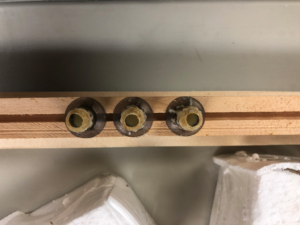

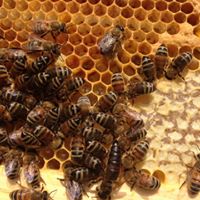
- For the year 2020, we grafted eggs from one Russian colony (the queen was provided by the USDA ARS Baton Rouge Bee Lab), one feral colony (Ohio feral), and one commercial colony (from GA) to generate at least 3 of 48-hr queen cells per stock. All queen cells were monitored. Three queen cells from Russian stock, three queen cells from feral colonies, and one commercial queen cell were successfully emerged, mated, and were placed into new nuc colonies with the same amount of worker bees. We supplemented two queens from other existing commercial colonies to make three queens available from commercial bee colonies.
- All these new queens were caged in the Jenter kit for 20-24 hours, then the number of eggs was recorded between August 2nd and September 5th, 2020.
- Additional information on pollen, adult numbers, and brood area was also recorded.
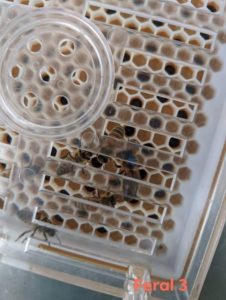
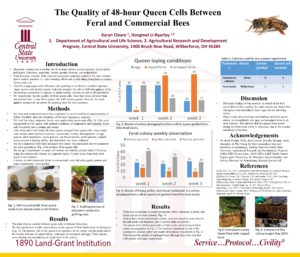
We carried out 2020 field experiments on the egg-laying behavior/rate of queens from different bee stocks (feral, Russian, and commercial package bees). The data from the experiment showed the egg-laying rate of Russian queens is significantly higher than feral and commercial honey bees. There is a trend that the egg-laying rate of feral honey bees is higher than that of commercial honey bees.
Educational & Outreach Activities
Participation Summary:
We have provided two workshops in Ohio for beekeepers in 2019. We are creating the course material and fact sheet for the workshop and the public. Participants have learned about queen biology, behavior, and development, genetic diversity, how to take care of 48-hr queen cells, how to do queen rearing, swarm traps, and sustainable apicultural practice.
We have presented our research at the Ohio State Fair, Ohio State Beekeepers Association conference in Nov. 2019, Undergraduate Research Symposium at Central State University in Oct. 2019, Greater Grand Lake Beekeepers Association meeting in Feb. 2020 in Saint Marys, Ohio, and American Bee Research Conference in Schaumberg IL in Jan. 2020.
We provided in-services for CSU Extension Educators in Jan. and Feb. 2021.
We are currently preparing a manuscript to submit to Apidologie (https://www.springer.com/journal/13592). The publication will report the field experiments and data we collected on the egg laying when we compared three different strains.
Attachments below are the survey from our 2021 webinar talks and participants' demographic distribution, and their evaluations/feedbacks.
Central State University Bee Webinar Series_ Caring for Honey Bee Queens Registration, Multiple Dates _ Eventbrite CSU Queen-Webinar Survey questions 2021 evaluation form 2021 webinar registration report-2021-04-07T1524 Webinar Survey results 2021
Learning Outcomes
queen quality, 48-hour queen cells, mite biting behavior
Project Outcomes
Twenty-five beekeepers of Ohio have practiced how to use the microscopes from our 2019 workshop. Thirteen beekeepers have checked the mite biting behavior on their new queen cell colonies in their own bee yards.
One grant is submitted to USDA AFRI and is awarded related to the mite biting behavior and initiates the breeding effort.
One grant is submitted to USDA CBG and is awarded related to the mite biting behavior.
One family to participate in is from Cedarville, OH. I'm very impressed by the passion of both the mother and son beekeepers. They are the stars of my participants, and their queen cells performed really well over winter. The son is in middle school, but he is already an experienced beekeeper with very active 4-H projects every year about beekeeping.
Information Products
- Queen Bee Fact sheet (Fact Sheet)
- Conference poster (Conference/Presentation Material)
